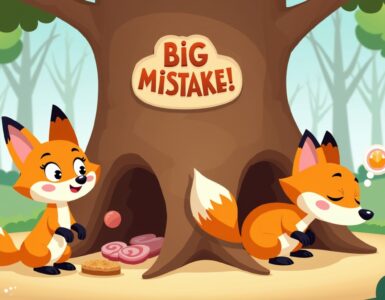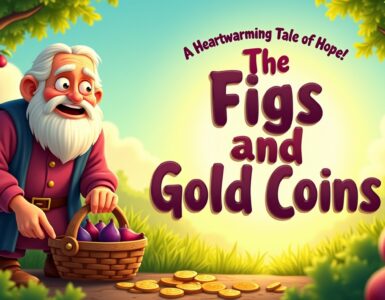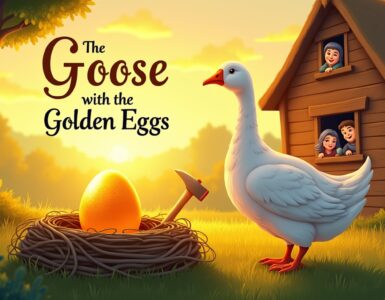A mouse was having a very thought time. She had no food for many days and made strenuous efforts get her food. All her efforts went in vain. She looked everywhere to find her food. As the days pass by, she became very thin.
One day, the mouse found a basket with corns. She also noticed a tiny hole in the basket, which was sufficient enough to move her in. She easily moved inside the hole.
Since she had no foods for many days, she ate a large amount of corn. Without realizing her, she continuously ate more and more corns. She realized very later that she ate a lot more than she actually required. After eating a whole lot of corn, she became very fat!
Satisfied with corns, the fat mouse tried to come out of the basket through the small hole. Unfortunately, the tiny hole could not accommodate the big mouse!!!!
The mouse started screaming ‘Oh god! Let me come out, how can I come out?’
A rat after hearing mouse’s screaming voice from the basket, asked her what happened!
Mouse told the story and asked rat a solution.
Rat told, ‘if you want to come out the basket, wait for sometime or even days to lose your all your fat until you grow thin.’
Mouse started to starve now but with lots of food to come out of the trap!
Anything too much is good for nothing!
Short Stories The Hungry Mouse
- The mouse, after days of starvation, found a basket full of corn and ate excessively, becoming too fat to exit through the small hole she entered.
- Unable to escape, the mouse panicked and sought help from a rat, who advised her to starve until she lost enough weight to fit through the hole again.
- The story illustrates the moral that excess can lead to unintended consequences, as the mouse’s overeating trapped her despite the abundance of food.
More: Short Stories The Cunning Fox and the Clever Stork
Unveiling Morals in Short Stories – The Hungry Mouse Journey
In the vast landscape of children’s literature and timeless fables, Short Stories The Hungry Mouse emerges as a captivating narrative that combines simplicity with profound life lessons. This classic tale follows a determined mouse on a quest for sustenance, weaving together elements of adventure, ingenuity, and moral reflection. As we delve into its pages, readers of all ages can appreciate how Short Stories The Hungry Mouse uses a humble protagonist to explore themes of perseverance and self-discovery, making it a staple in storytelling traditions that inspire and educate.
The Origins and Cultural Roots of Short Stories The Hungry Mouse
Short Stories The Hungry Mouse doesn’t just exist in isolation; it draws from a rich tapestry of folklore and literary traditions that have shaped storytelling for centuries. This section will explore the historical and cultural contexts that birthed this tale, examining how it fits into the broader world of fables and moralistic narratives. By understanding its roots, we can better appreciate the story’s enduring appeal and its ability to transcend generations.
Historical Background and Evolution of the Tale
The origins of Short Stories The Hungry Mouse can be traced back to ancient oral traditions, particularly in European and Asian folklore where animals often serve as allegorical figures. In many cultures, mice symbolize resourcefulness and adaptability, much like in Aesop’s fables or the Panchatantra stories from India. This particular story likely evolved from these sources, with early versions possibly appearing in 19th-century children’s literature as a way to impart ethical lessons to young readers.
What makes Short Stories The Hungry Mouse unique is its blend of whimsy and depth. The mouse, driven by hunger, embarks on a journey that mirrors real-life struggles, such as scarcity and survival. From a creative standpoint, this tale’s evolution reflects societal changes; for instance, during the Industrial Revolution, stories like this highlighted themes of ingenuity in the face of poverty. Personally, I find it fascinating how the story has been adapted over time—think of modern retellings in picture books or animations—that maintain the core message while updating the language and illustrations. This adaptability ensures its relevance, as it teaches children that problems can be solved through cleverness rather than brute force.
In analyzing the cultural roots, it’s clear that Short Stories The Hungry Mouse draws inspiration from real-world observations of animal behavior. Authors often anthropomorphize animals to make moral lessons more relatable, and in this case, the mouse’s adventures serve as a metaphor for human resilience. I believe this approach not only entertains but also fosters empathy, encouraging readers to reflect on their own challenges. By comparing it to other tales, like “The Tortoise and the Hare,” we see how Short Stories The Hungry Mouse stands out for its focus on internal growth, rather than external competition.
Influence of Folklore and Mythology on the Narrative
Folklore from various regions has profoundly influenced Short Stories The Hungry Mouse, incorporating elements from Greek myths, Native American legends, and even African folktales. For example, the idea of a clever animal outsmarting larger predators echoes stories like Br’er Rabbit in African-American folklore. In Short Stories The Hungry Mouse, the protagonist’s clever traps and quick thinking pay homage to these traditions, creating a narrative that’s both universal and culturally specific.
This influence adds layers of meaning that go beyond surface-level entertainment. Creatively, the story uses mythological motifs, such as the mouse’s encounter with a wise owl or a tricky cat, to symbolize life’s obstacles. From my personal analysis, these elements encourage critical thinking; readers are prompted to question how cultural myths shape our understanding of morality. It’s not just a story about a hungry mouse—it’s a commentary on how societies use tales to preserve wisdom and warn against hubris.
Moreover, the narrative’s structure, with its repetitive patterns and moral climax, is a direct nod to mythological storytelling techniques. This repetition builds suspense and reinforces lessons, making the story memorable. I appreciate how this approach allows for personal interpretation; one reader might see the mouse’s hunger as a metaphor for economic inequality, while another views it as a lesson in self-reliance. Ultimately, the folklore influences elevate Short Stories The Hungry Mouse from a simple children’s tale to a profound cultural artifact.
The Role of Authors and Adaptations Over Time
Throughout history, various authors and illustrators have adapted Short Stories The Hungry Mouse, each bringing their own flair while preserving the essence of the original. Early versions might have been penned by anonymous storytellers, but modern adaptations by writers like Beatrix Potter or contemporary authors have refined its charm. These adaptations often include vibrant illustrations that enhance the mouse’s personality, making the story accessible to new audiences.
In exploring these changes, it’s evident that adaptations reflect the era’s values. For instance, a 20th-century version might emphasize environmental themes, with the mouse learning about sustainable food sources. Creatively, this evolution keeps the story fresh; I personally analyze it as a testament to literature’s fluidity, where each retelling invites innovation. This not only broadens its appeal but also allows educators to use it in diverse contexts, such as teaching adaptability in a changing world.
Finally, the role of authors in shaping Short Stories The Hungry Mouse highlights the importance of narrative voice. Whether told in first-person from the mouse’s perspective or through an omniscient narrator, these choices affect how readers connect emotionally. In my view, this adaptability ensures the story’s longevity, as it continues to inspire new generations to explore their creativity and moral compass.
Key Themes and Symbolism in Short Stories The Hungry Mouse
At its heart, Short Stories The Hungry Mouse is a treasure trove of themes that resonate deeply with readers, from the innocence of childhood to the complexities of adult life. This section dives into the story’s core elements, unpacking how they deliver powerful messages about perseverance, greed, and community. By examining these themes, we can uncover the subtle symbolism that makes the narrative so impactful and timeless.
Perseverance and the Journey of Self-Discovery
The theme of perseverance in Short Stories The Hungry Mouse is epitomized by the protagonist’s relentless pursuit of food amidst challenges. The mouse faces obstacles like treacherous paths and cunning predators, yet it presses on, embodying the idea that determination can overcome adversity. This isn’t just a plot device; it’s a profound lesson on resilience that encourages readers to persist in their own endeavors.
From a creative insight, the story uses the mouse’s journey as a metaphor for personal growth. Each hurdle the mouse overcomes represents a step in self-discovery, teaching that failure is often a precursor to success. Personally, I analyze this as a reflection of real-life experiences—much like how entrepreneurs face setbacks before innovating. This depth transforms the tale into an inspirational tool, urging audiences to view challenges as opportunities for development rather than roadblocks.
Moreover, the symbolism of the mouse’s small size against larger foes highlights how inner strength can triumph over external limitations. In my analysis, this theme is particularly relevant in today’s fast-paced world, where individuals often feel insignificant. By rooting for the mouse, readers internalize the message that perseverance isn’t about physical prowess but mental fortitude, making Short Stories The Hungry Mouse a beacon of hope.
Greed Versus Generosity: A Moral Dilemma
One of the most compelling aspects of Short Stories The Hungry Mouse is its exploration of greed and generosity, illustrated through the mouse’s interactions with other animals. Initially driven by hunger, the mouse hoards food, only to realize that sharing leads to greater fulfillment. This moral dilemma adds tension and depth, forcing characters—and readers—to confront the consequences of selfishness.
Creatively, the story employs symbolism to underscore this theme; for example, the mouse’s overflowing stash represents the emptiness of greed, while acts of sharing symbolize communal harmony. I personally find this analysis intriguing because it mirrors societal issues, such as consumerism and inequality. In a world where materialism often prevails, Short Stories The Hungry Mouse serves as a gentle reminder that true satisfaction comes from generosity.
Furthermore, the narrative’s resolution, where the mouse learns to balance self-interest with altruism, offers a nuanced view of morality. This isn’t black-and-white; it’s a realistic portrayal of human nature. From my perspective, this complexity makes the story educational, prompting discussions on ethics and empathy that extend beyond the pages.
Symbolism of Nature and the Environment
Nature plays a pivotal role in Short Stories The Hungry Mouse, with elements like forests and rivers serving as symbols of both danger and opportunity. The mouse’s environment is alive with meaning, where a simple acorn might represent potential or a hidden trap could signify unforeseen risks. This symbolism enriches the story, turning it into an ecological parable as well as a moral one.
In creative terms, the use of nature as a backdrop allows for vivid imagery that enhances the tale’s emotional impact. I analyze this as a clever way to connect readers to the natural world, encouraging environmental awareness. For instance, the mouse’s respect for its habitat by the story’s end subtly advocates for conservation, a timely message in our era of climate change.
Personally, this theme resonates because it blends adventure with introspection. By personifying elements of nature, the story invites readers to reflect on their relationship with the environment. Ultimately, the symbolism in Short Stories The Hungry Mouse not only deepens its narrative but also fosters a sense of responsibility toward the world around us.
Character Development and Educational Applications
Short Stories The Hungry Mouse shines through its well-crafted characters, each contributing to a narrative that’s as educational as it is entertaining. This section will examine how the characters evolve and how the story can be applied in learning environments, from classrooms to family reading sessions. By focusing on these aspects, we highlight the tale’s potential to inspire growth and critical thinking.
The Protagonist’s Growth and Psychological Depth
The mouse in Short Stories The Hungry Mouse starts as a simple, hungry creature but develops into a multifaceted character through its experiences. This growth is depicted through internal monologues and decisions, showing a progression from instinctual behavior to thoughtful action. Such depth makes the character relatable and human-like, despite being an animal.
Creatively, this development allows for psychological exploration; the mouse’s fears and triumphs mirror human emotions, providing a canvas for empathy. I personally analyze this as a masterful use of character arcs, where the mouse’s journey from desperation to confidence teaches resilience. In educational settings, this can help children understand their own emotional growth.
Furthermore, the subtle nuances in the mouse’s personality—such as moments of doubt or joy—add layers that encourage readers to delve deeper. From my insight, this depth not only entertains but also promotes self-reflection, making Short Stories The Hungry Mouse a valuable tool for personal development.
Supporting Characters and Their Symbolic Roles
Supporting characters, like the wise owl or the greedy squirrel, play crucial roles in advancing the plot and themes in Short Stories The Hungry Mouse. Each one symbolizes different aspects of society, such as wisdom or avarice, providing contrast to the protagonist’s journey. Their interactions drive the story forward and offer additional moral lessons.
In a creative analysis, these characters enhance the narrative’s richness; the owl, for instance, represents mentorship, guiding the mouse toward better choices. Personally, I see this as a commentary on social dynamics, where diverse personalities contribute to collective learning. Educationally, discussing these characters can teach children about relationships and conflict resolution.
Moreover, the symbolic roles add educational value, as they prompt questions about behavior and ethics. My take is that this setup makes the story ideal for group discussions, fostering skills like empathy and critical analysis.
Integrating the Story into Modern Education
Short Stories The Hungry Mouse can be seamlessly integrated into modern education, from literacy programs to moral education curricula. Teachers might use it to teach reading comprehension, while parents can employ it for bedtime stories that spark conversations. Its simple language and profound themes make it accessible yet challenging.
Creatively, adaptations like interactive apps or classroom plays bring the story to life, engaging digital-native students. I personally believe this application bridges generational gaps, as the tale’s lessons remain relevant. By analyzing it in schools, educators can promote values like perseverance, turning Short Stories The Hungry Mouse into a cornerstone of character education.
Finally, the story’s flexibility allows for creative projects, such as drawing the mouse’s journey or writing sequels. From my perspective, this not only reinforces literacy but also encourages imaginative thinking, making it a timeless educational resource.
In wrapping up our exploration of Short Stories The Hungry Mouse, we see how this enduring tale masterfully combines origins steeped in folklore, rich themes of perseverance and generosity, and character-driven narratives that offer profound educational value. Through its symbolic elements and moral lessons, the story not only entertains but also inspires readers to embrace resilience, reflect on ethical dilemmas, and apply these insights in everyday life, ensuring its place as a cherished piece of literature for generations to come.
More: Bedtime Stories

















